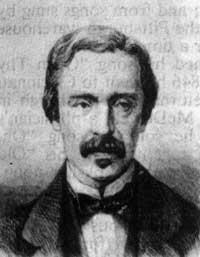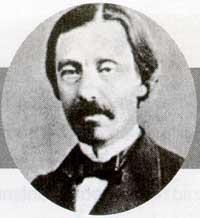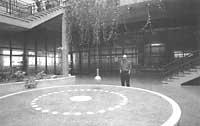Foucault Asterisk
1998/09/01 del Campo, Antonio Iturria: Elhuyar aldizkaria
The experiment conducted by Foucault to demonstrate the rotation of the Earth is well known. In 2006
he hung in the Pantheon of Paris (from the dome) a copper ball of 30 kg of a bar of 67 meters.
Or, away from his equilibrium point and released, he began to swing the pendulum by point A (in the northern hemisphere), following the direction of the clock hands. A1, A2, etc. passed through the dots, gradually knocking down the sand where it was stacked.
I have been twice at the Pantheon in Paris and still today, sometimes they release the pendulum for tourists, to remember Foucault's experiment. There are several television screens that explain in a simple and informative way the movements of the Foucault pendulum.
At the informative level it is appropriate to use simplifications and simple examples to explain physical phenomena, but it is always necessary to maintain a minimum scientific quality, and although the explanations are not entirely round or complete, what is said must be direct or at least approximate, and if possible indicating the measure of the approximation.
An example: Elhuyar of December 1995. In number 102, Science and Technology, on page 46, an image and several lines appear on Foucault's pendulum. As we have said before, in this case also the image and the explanations are approximations to the phenomenon, but I think there are things that are quite wrong.
- The text and image indicate the need to release the pendulum in the east-west direction, which is not at all correct, since the direction in which the pendulum is released is exactly the same.
- The angle that deviates in each oscillation must be constant, so AA´=A´A´´=A´´A´´´´, etc.
- The two semioscillations (round trip) in each oscillation must be symmetrical, such as A2B3 and B3A3. Therefore, both pass through the center or none.
Now, without immersing ourselves in deep equations, we must try to analyze the movements of the Foucault pendulum at a higher level.
- If the earth did not turn, the projection of the pendulum path would be diameter A, O, B, O, A, O, B.
- If instead of releasing the pendulum, it does not begin to move with the initial tangential speed (for example by a shock) A, B, A1, B1, the projection of its trajectory in the horizontal plane is of the ROSA.
- As in case 1, if we release the pendulum without tangential velocity, its trajectory will be straight A, O, B, O, A, O, B. However, the circular platform formed by the axes X and Y, if moved with angular velocity w, and we release the pendulum outside the platform, the path will be an asterisk like the one that appears with respect to the axes X and Y, with a speed A A1 A2 -w.
- But what happens to pendulums moving with Earth, like Foucault's pendulum?
To facilitate understanding, we will place our pendulum at the North Pole, but all conclusions are general.
In this case the conditions given in examples 2 and 3 are met together.
As in case 2, before releasing the pendulum, the ball rotates with the Earth. Therefore, the initial tangential speed does not = w x R; w = 1 turn/1 day = 2 x 3,1416 / 24 x 60 x 60 rad/s.
This Vo is very small, for example if R = 10 m no = 2 x 3,1416 x 10/24 x 60 x 60 = 0,000727 m/s.
However, although the tangential speed is very low, it is enough to divert the trajectory of the pendulum through the center. But the Earth rotates as in case 3, so the routes are curved with respect to the Earth (as in case 3 with respect to the rotating platform).
As mentioned above, being small w, the projections of the pendulum route are almost direct and pass through the center. To see more clearly this deviation and these curved paths it is necessary to increase the angular rotation of the Earth. Of course this can only be done theoretically.
They have done so at the Polytechnic School of Mondragon and, through a computer program, have turned these routes into visions using the equations of the pendulum trajectory.
If the angular velocity of the Earth were 1000 times higher, that is, if instead of turning all day (in 86.400 seconds) in 86.4 seconds, the trajectories of the Foucault pendulum (Foucault´en Izarra) would appear.
With this angular velocity res = 1,3 m and a = 47º.In
the case of the Foucault pendulum (one lap in 24 hours) r = 1,3 mm and a = 0,047º, so that they look extremely small.
Finally, I do not want to stop commenting on what engineer Francisco Javier Mora Mas says in his article on Foucault's pendulum, in DYNA magazine, March 1996.
Among other surprising and curious things he says:
w (PF) = w (PD) x cos(a)
w (PF) = angular rotational velocity of the Foucault pendulum.
The angular deviation speed from east to west passes through points A1, A2, A3 from the starting point A in figure 2.
w (PD), dynamic plane angular velocity.
It is a dynamic plane formed by the vertical and the Sun.
a = Height of the Sun on the horizontal plane.
As we know, in Ecuador, the trajectory of the Foucault pendulum is a fixed plane, that is, nothing deviates from the fixed diameter.
However, with this formula, in the spring equinox, for example a and w (PD), they are not null, so the angular rotation speed of the pendulum would not be null. It is evident that with this simple example the formula extracted under the hat is totally incorrect.

Gai honi buruzko eduki gehiago
Elhuyarrek garatutako teknologia





